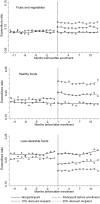A cash-back rebate program for healthy food purchases in South Africa: results from scanner data
- PMID: 23683973
- PMCID: PMC3659342
- DOI: 10.1016/j.amepre.2013.02.011
A cash-back rebate program for healthy food purchases in South Africa: results from scanner data
Abstract
Background: Improving diet quality is a key health promotion strategy. There is much interest in the role of prices and financial incentives to encourage healthy diet, but no data from large population interventions.
Purpose: This study examines the effect of a price reduction for healthy food items on household grocery shopping behavior among members of South Africa's largest health plan.
Methods: The HealthyFood program provides a cash-back rebate of up to 25% for healthy food purchases in over 400 designated supermarkets across all provinces in South Africa. Monthly household supermarket food purchase scanner data between 2009 and 2012 are linked to 170,000 households (60% eligible for the rebate) with Visa credit cards. Two approaches were used to control for selective participation using these panel data: a household fixed-effect model and a case-control differences-in-differences model.
Results: Rebates of 10% and 25% for healthy foods are associated with an increase in the ratio of healthy to total food expenditure by 6.0% (95% CI=5.3, 6.8) and 9.3% (95% CI=8.5, 10.0); an increase in the ratio of fruit and vegetables to total food expenditure by 5.7% (95% CI=4.5, 6.9) and 8.5% (95% CI=7.3, 9.7); and a decrease in the ratio of less desirable to total food expenditure by 5.6% (95% CI=4.7, 6.5) and 7.2% (95% CI=6.3, 8.1).
Conclusions: Participation in a rebate program for healthy foods led to increases in purchases of healthy foods and to decreases in purchases of less-desirable foods, with magnitudes similar to estimates from U.S. time-series data.
Copyright © 2013 American Journal of Preventive Medicine. Published by Elsevier Inc. All rights reserved.
Figures


References
-
- WHO. Global strategy on diet, physical activity and health. 2004 apps.who.int/gb/ebwha/pdf_files/WHA57/A57_R17-en.pdf.
-
- An R. Effectiveness of subsidies in promoting healthy food purchases and consumption: a review of field experiments. Public Health Nutr. 2012;5:1–14. dx.doi.org/10.1017/S1368980012004715. - DOI - PMC - PubMed
-
- U.S. Department of Agriculture Foreign Agricultural Service. 2010 annual retail food sector report of South Africa. 2011 gain.fas.usda.gov/Recent%20GAIN%20Publications/Retail%20Foods_Pretoria_S... rica%20-%20Republic%20of_1-5-2011.pdf.
-
- DHHS and U.S Department of Agriculture. Dietary guidelines for Americans, 2005. 6th. Washington DC: U.S. Government Printing Office; 2005.
Publication types
MeSH terms
Grants and funding
LinkOut - more resources
Full Text Sources
Other Literature Sources
Miscellaneous

